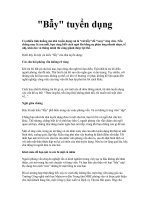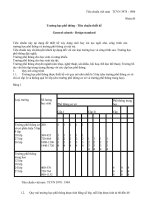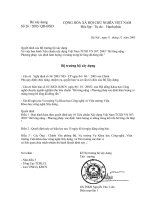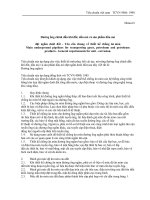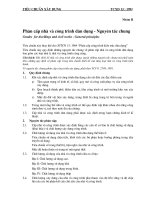Tài liệu Market Research Toolkit doc
Bạn đang xem bản rút gọn của tài liệu. Xem và tải ngay bản đầy đủ của tài liệu tại đây (225.25 KB, 58 trang )
CONFIDENTIAL
Market Research Toolkit
MARKETING SCIENCE CENTER
September 1995
ST-ZXe247/950830SeaHR1
TABLE OF CONTENTS
Qualitative Focus groups
In-depth interviews
Observational research
Quantitative Quick hit
Basic A&U
Concept test
Attitudinal
Image engineering
Conjoint analysis
Discrete choice
Customer service
Diary panel
ST-ZXe247/950830SeaHR1
2
MARKETING SCIENCE CENTER
John Forsyth – ST
Mike Sherman – NY
Kevin Nuffer – NY
Anil Kaul – NY
Mark Leiter – NY
KK Davey – NY
Joshua Goff – NY
Rich Milliman – AT
Neil Allison – SF
Linda Middleton – CH
Sudeep Haldar – CH
Xavier Azalbert – LN
Angela Lovejoy – LN
Sid Simmons – LN
Nirmala Santiapillai – LN
Bernhard von Skerst – HA
Mark Esser – DU
Peter Prins – AM
Rama Bijapurkar – BY
The objective of this document is to provide a quick overview of market
research techniques. More detail can be found in the Market Research
Handbook (PD Net #6229) or by contacting a marketing science specialist.
ST-ZXe247/950830SeaHR1
3
TWO TYPES OF TECHNIQUES
Qualitative Quantitative
Objective Generates hypotheses on decision
makers, buying process, and key
buying function (KBF)
Tests and quantifies hypotheses
Tools available Focus groups
In-depth interviews
Observational research
Quick hit
Basic A&U
Concept test
Attitudinal
Image engineering
Conjoint analysis
Discrete choice
Customer service
Diary panel
There are two types of market research techniques: qualitative and
quantitative. Generally, a research program starts with qualitative to generate
hypotheses and quantitative to prove them.
ST-ZXe247/950830SeaHR1
4
What is it? Approximately a two hour discussion among 8 to 12 people, led by a
moderator
When do you use it? Early in the research process, to clarify the issues, generate ideas on
hypotheses, and help determine what other research to conduct. This is
particularly the case when there is little information on the subject
or, when time and money are very limited, as the only research tool –
particularly when you don't expect a wide divergence of views
How do you do it? Hire a moderator
Recruit participants
Prepare a discussion guide
Attend focus group(s)
Videotape the groups
Debrief moderator to determine conclusions
What do you get out it? A summary of key findings and well developed hypotheses for answering
certain key issues
Approximate cost $3,000 - $5,000 for each group of 10 consumer respondents
Project typically two to six groups
Approximate time To develop discussion guide, generate hypotheses: 2 weeks
To conduct: in 1 week you can expect to conduct three to four groups if
several cities are involved
To synthesize findings/refine hypotheses: 1 to 2 weeks
FOCUS GROUPS
ST-ZXe247/950830SeaHR1
5
FOCUS GROUP OUTPUT PAGE
Issue Discussion output Quotes Implications
Sales force Customer think salespeople
are lazy
Methods to improve the
sales force did not surface
"They never follow up"
"I'm not even sure who
my sales guy is"
Need to focus the
salesperson portion of the
questionnaire on how to
improve the sales force
Competition Little agreement as to who
the competition is
"We compete with XYZ
head to head"
"I never lose sales to
XYZ. Dillon and Peters
are my main competition
Let respondent define their
competition on questionnaire
– do not define it for them
Have section in questionnaire
to find out who competes with
who, and why
ST-ZXe247/950830SeaHR1
6
What is it? One-on-one interviews usually lasting at least 45 minutes
Primary research tool when only have a few customers
When do you use it? Similar to focus groups, in-depth interviews are used to:
• Explore issues and underlying details
• Develop hypotheses
• Gain an understanding of key buying factors and brands
• Discover the language customers use
Likewise, they can add value after quantitative research to further get your
hands around the findings
One-on-one are preferred to focus groups when:
• There exists specific people you wish to speak with
• Qualified respondents are few in number
• Specific issues requiring confidentiality, sensitivity or probing
How do you do it? Hire a moderator
Recruit participants
Prepare a discussion guide
Debrief moderator
What do you get out it? A summary of key findings
Well developed hypotheses
Potential product/service definitions for quantitative research
Approximate cost Projects typically $100 to $300 per interview
Approximate time Interviews usually last 45 minutes to 2 hours
IN-DEPTH INTERVIEWS
ST-ZXe247/950830SeaHR1
7
INTERVIEW WITH JOE BLOGGS, 34 YEARS OLD, 2 KIDS, C2
On February 1, 1994 we met with Joe Bloggs and his wife. The purpose of the
discussion was to understand the decision making process they go through when
buying financial services.
Key points
1. They make a joint decision when buying insurance.
2. They like the appeal of a "one stop shop" with one company.
3. They dislike home service and find it uncomfortable but instead prefer
using the telephone.
Issues
1. An in-depth study of cross-selling opportunities and appeal would be
beneficial.
2. A more thorough understanding of selling channels would be useful.
Next steps
Quantify segment size and scale of opportunities
ST-ZXe247/950830SeaHR1
8
OBSERVATIONAL RESEARCH
What is it? A qualitative technique to observe customers
When do you use it? To identify potential new products and services
What do you get out of it? Hypotheses on latent demand from observing behavior
and problems customers face
Approximate costs Varies
Approximate timing Varies
ST-ZXe247/950830SeaHR1
9
Many companies are observing decision makers for new insights into the
customer.
EXAMPLES OF OBSERVATIONAL RESEARCH
• A pharmaceutical company followed GPs around all day to identify
problems/stresses they face.
• Honda sent R&D engineers to rent rooms in houses in California to see
how Americans interact with their cars.
• Small video cameras in retail stores record how consumers make
decisions at the shelf.
• Ivory soap was created by seeing women who tended to lose the soap
when washing clothes in the Ohio River.
ST-ZXe247/950830SeaHR1
10
Listed below are some best practices for using qualitative research.
HELPFUL HINTS FOR QUALITATIVE
• Generate hypotheses before qualitative to help structure research.
• Take stimuli (e.g., pictures) into qualitative to facilitate discussion.
• Be sure to be complete. You need to have an exhaustive list of key hypotheses.
• Attend the sessions. Videotape them for others not able to attend. Develop a
first-hand point of view.
• Do not be too literal. People frequently are unable to articulate their precise
thoughts.
ST-ZXe247/950830SeaHR1
11
Quantitative studies seek to prove hypotheses with data from a statistically
representative sample.
QUANTITATIVE TECHNIQUES
Quick hit research Is a short, very focused quantitative survey
Basic quantitative
(usage and attitude)
Measures basic beliefs and behaviors for a category
Concept testing Judges consumer reactions to specific new product idea
Attitudinal Measures category attitudes for latent demand situations
Image modeling Analyzes effects of brand imagery
Conjoint analysis Measures trade-offs of product/services features and price
Discrete choice Measures in-depth trade-offs of a few features and price
Problem detection Understands root causes of why customers leave
Customer service
modeling
Prioritizes specific elemenst of customer service
Diary panel Track consumer purchases over time
ST-ZXe247/950830SeaHR1
12
QUICK HIT RESEARCH
What is it? A very short quantitative questionnaire done very
quickly
When do you use it? To answer a very focused set of issues
What do you get out of it? A quantitative answer quickly
Approximate costs Typically under $20,000
Approximate timing Typically 1 to 3 weeks
ST-ZXe247/950830SeaHR1
13
EXAMPLES OF QUICK HIT RESEARCH
• Interviewing at conventions to target a
hard-to-reach group (e.g., Convention
Research Studies)
• Adding a few selected questions to
omnibus studies (e.g., Telenation at
Market Facts)
• Targeting hard-to-reach consumer
groups in a touch tone telephone survey
(e.g., Yankelovich Project Advantage)
• Identifying new products and services
opportunities among a key customer
group, e.g., club member
• Profiling corporate identities among
women's issues
• Determining price awareness for an
impulse product
Many companies use "quick hit" research for a very focused set of issues.
ST-ZXe247/950830SeaHR1
14
Turning to Yankelovich as a source, we have a strong relationship (in some
ways, partnership) with Yankelovich to conduct quick "surveys" in their
continual phone interviews drawing on a 16,000 respondent database (see
separate document, McKinsey & Yankelovich Partnership on Project Advantage by
Kevin Nuffer, January 1995).
OVERVIEW – WHAT IS IT?
A respondent database . . . linked to . . . a rapid turnaround survey
capability
• 16,000 households
• Extensive background data
– Demographics
– Econographics
– Product usage
– Media habits
– Attitudinal battery
• Capability to conduct surveys up
to 10 minutes long via
interactive voice response (IVR)
telephone system
• "Intelligent" sampling from
database
• Surveys completed in 2 or 3
days – start to finish
ST-ZXe247/950830SeaHR1
15
What is it? Survey that measures basic beliefs about a category and identifies groups
of customers by their needs
When do you use it? When purchase decision is straightforward
When client has never done research before and has little quantitative
information
How do you do it? Hypothesize key buying factors
Develop a range of KBF statements
Measure consumer importance and competitive brand positioning on the
KBFs
Identify segments by KBFs
Link segments to reported purchase behavior
Cross reference with other data to identify gaps
What do you get out it? A better understanding of customers' perceptions of products/services in
the marketplace and some ideas for ways to position products
Approximate cost $30 to $150 per consumer respondents
Approximate time 1 to 2 weeks for qualitative research
6 to 10 weeks to design, execute, and analyze research
DESCRIPTION OF TOOLS – BASIC QUANTITATIVE (USAGE AND ATTITUDE)
ST-ZXe247/950830SeaHR1
16
TYPICAL QUESTIONS
Buying factor Importance* Brand A Brand B Brand C
Good service
Lowest prices
Broad selection of
styles
Known brands
Latest fashions
Competitive ratings on delivery of the buyer factor*
The usual A&U questions probe the importance of key buying factors and
competitive perceptions on each.
* Scale of 1-10
ST-ZXe247/950830SeaHR1
17
COMPETITIVE RATINGS FOR A RETAILER
* 10 point scale
ILLUSTRATIVE
Good service
Latest fashions
Broad selection of styles
Lowest prices
Known brands
6.4
6.4
6.0
5.6
5.5
KBF Importance*
0 1 2 3 4 5 6 7
Rating*
All have weak
service
Brand strength
is fashionability,
selection
Weakness is
price
Range of competition
Our brand
For example, this retailer has a competitive strength in fashionability but is
weak on price.
ST-ZXe247/950830SeaHR1
18
CASUAL WEAR NEEDS
Average
Source: Market research
-0.4
-1.6
0.2
2.1
0
-1
0
-0.6
0
1.7
0
2.9
-0.2
-1.4
-0.2
0.8
0.6
0.2
-0.9
-0.6
Good service 6.4
Latest fashions 6.4
Broad selection
of styles
6.0
Lowest prices 5.6
Known brands 5.5
ILLUSTRATIVE
Total
average
Segment A Segment B Segment C Segment D
However, results should be understood by segment, each of whom have a
different priority of needs.
ST-ZXe247/950830SeaHR1
19
CONCEPT TESTING
What is it? A research technique based on one-on-one interviews where
consumers react to a specific new product idea
When do you use it? When you need to assess a specific new product idea
When you are confident you have defined the new idea properly
How do you do it? Write a concept (similar to a print ad)
Conduct interviews:
• Current brands used
• Habits and practices
• Read concept
• Intent to purchase
• Likes and dislikes
• Image ratings
Project share/volume with calibration factors
What do you get out of it? Share/volume for new product idea
Approximate cost $75 to $300 per interview
Approximate time 6-10 weeks to design, execute, and analyze research
ST-ZXe247/950830SeaHR1
20
CONCEPT TESTING
Picture
Description of the new product
idea including its benefits,
price, brand. This should be
similar to a magazine ad but
with less advertising hype
Questions asked
• Purchase intent
• Likes and dislikes
• Hedonic
• Price/value
• Uniqueness
• Preference versus
potential competition
• Perceptions on KBFs
• Image ratings
In a concept test, respondents' reactions to a new idea are gauged.
ST-ZXe247/950830SeaHR1
21
CONCEPTS CAN BE CALIBRATED TO TRIAL
Purchase intent
Percent of
respondents Calibration*
Definitely would buy 50% 75
Probably would buy 30 35
Might or might not buy 15 5
Probably would not buy 5 0
Definitely would not buy 0 0
* Some research agencies have good experimental databases on calibration. Numbers are culturally and sometimes category
dependent
= 48.8%
19.5%
x 50%
x 80%
– Interested universe
– Awareness
– Distribution
– Predicted trial
Concept purchase intent can be converted in trial rates, though the calibration
factors are a key assumption. Certain market research firms specialized in this
and have good databases and experiences. A marketing science specialist can
help you find the appropriate firm.
ST-ZXe247/950830SeaHR1
22
STRETCHING CAN BE EVALUATED
Current
brand
New
concept
KBFs
Able to stretch these
key elements
Both have same
weaknesses
By evaluating the perceptions of a new concept versus a current brand, we can
analyze when it is possible to stretch a brand and where the brand is too strong
to move.
Gives good service
Is prestigious
Has latest fashions
Has lowest price
Has known brands
0 1 2 3 4 5 6 7
Rating
23
ATTITUDAL RESEARCH
What is it? Analysis based on individual interviews that identify groups of customers by their
attitudes and perceived benfits toward the product or service or the product
category
When do you use it? In latent demand situations, when a market does not currently exist for the product
When decisions involve complex issues such as multiple categories and future
trends
How do you do it? Hypothesize key attitudes and develop statements
Measure customer agreement
Identify segments by attitude needs
Link segments to reported purchase behavior
Cross reference with other data to identify gaps
Determine likely acceptance of new/revised value propositions
What do you get
out of it?
A better understanding of customers' attitudes toward products/services in the
marketplace and some ideas for ways to leverage those attitudes to position
products
Approximate cost $50 to $300 per consumer interview
Approximate time In one week 300 half hour phone interviews or 200 half-hour personal interviews
1-2 weeks for qualitative research
6-10 weeks to design execute and analyse research
ST-ZXe247/950830SeaHR1
24
Attitudinal segmentation is based on agreement to attitude/need statements.
Each statement expresses customer's agreement towards a specific idea.
EXAMPLES OF ATTITUDE STATEMENTS
1. Telecom services are essential for my business
2. It is very important for my business to receive bills for each
extension
3. It is not necessary to understand my business to sell me
telecom services
4. Mobile phones are very critical for proper functioning of my
business
5. We definitely prefer to buy all our telecom services from one
vendor
6. It is very important for my business to have direct numbers for
employees
7. We prefer to deal with a telecom company that has good
service rather than just a low price
8. If my employees are traveling they should be able to be in
phone contact with their home office
9. I would definitely prefer to have my telecom company
representative call me regularly to inform me about new
products/services
10. All I want is basic telecom products and services.
1234567
1234567
1234567
1234567
1234567
1234567
1234567
1234567
1234567
1234567
Totally
agree
Totally
disagree

